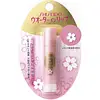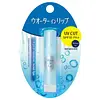What's inside
What's inside
 Key Ingredients
Key Ingredients

 Benefits
Benefits

 Concerns
Concerns

 Ingredients Side-by-side
Ingredients Side-by-side

Stearyl Glycyrrhetinate
Skin ConditioningTocopheryl Acetate
AntioxidantGlucosyl Hesperidin
HumectantPEG/PPG-36/41 Dimethyl Ether
Skin ConditioningCitrus Limon Fruit Extract
MaskingGlycerin
HumectantMethyl/Phenyl Polysilsesquioxane
Paraffinum Liquidum
EmollientErythrityl Triethylhexanoate
EmollientPolyethylene
AbrasiveParaffin
PerfumingMicrocrystalline Wax
Emulsion StabilisingPolyglyceryl-6 Diisostearate
EmulsifyingButylene Glycol
HumectantWater
Skin ConditioningSilica
AbrasiveMenthol
MaskingTocopherol
AntioxidantOrange Roughy Oil
Skin ConditioningPEG-8 Dimethicone
EmulsifyingAscorbyl Dipalmitate
AntioxidantPolydiethylsiloxane
EmollientPEG-3 Glyceryl Triisostearate
EmollientTrimethylolpropane Triethylhexanoate
EmollientTetradecene
EmollientTetramethylcyclotetrasiloxane
Titanium Dioxide
Cosmetic ColorantCI 77491
Cosmetic ColorantCI 77492
Cosmetic ColorantStearyl Glycyrrhetinate, Tocopheryl Acetate, Glucosyl Hesperidin, PEG/PPG-36/41 Dimethyl Ether, Citrus Limon Fruit Extract, Glycerin, Methyl/Phenyl Polysilsesquioxane, Paraffinum Liquidum, Erythrityl Triethylhexanoate, Polyethylene, Paraffin, Microcrystalline Wax, Polyglyceryl-6 Diisostearate, Butylene Glycol, Water, Silica, Menthol, Tocopherol, Orange Roughy Oil, PEG-8 Dimethicone, Ascorbyl Dipalmitate, Polydiethylsiloxane, PEG-3 Glyceryl Triisostearate, Trimethylolpropane Triethylhexanoate, Tetradecene, Tetramethylcyclotetrasiloxane, Titanium Dioxide, CI 77491, CI 77492
Stearyl Glycyrrhetinate
Skin ConditioningMenthol
MaskingParaffinum Liquidum
EmollientMethyl/Phenyl Polysilsesquioxane
Glyceryl Ethylhexanoate
EmollientPolyethylene
AbrasiveEthylhexyl Methoxycrylene
Skin ConditioningParaffin
PerfumingPentaerythrityl Tetraethylhexanoate
EmollientSodium Magnesium Silicate
Microcrystalline Wax
Emulsion StabilisingPEG/PPG-36/41 Dimethyl Ether
Skin ConditioningWater
Skin ConditioningPEG-8 Dimethicone
EmulsifyingDipropylene Glycol
HumectantGlycerin
HumectantMica
Cosmetic ColorantSilicon
AbrasiveTocopherol
AntioxidantSodium Hyaluronate
HumectantStearyl Glycyrrhetinate, Menthol, Paraffinum Liquidum, Methyl/Phenyl Polysilsesquioxane, Glyceryl Ethylhexanoate, Polyethylene, Ethylhexyl Methoxycrylene, Paraffin, Pentaerythrityl Tetraethylhexanoate, Sodium Magnesium Silicate, Microcrystalline Wax, PEG/PPG-36/41 Dimethyl Ether, Water, PEG-8 Dimethicone, Dipropylene Glycol, Glycerin, Mica, Silicon, Tocopherol, Sodium Hyaluronate
 Reviews
Reviews

Ingredients Explained
These ingredients are found in both products.
Ingredients higher up in an ingredient list are typically present in a larger amount.
Glycerin is already naturally found in your skin. It helps moisturize and protect your skin.
A study from 2016 found glycerin to be more effective as a humectant than AHAs and hyaluronic acid.
As a humectant, it helps the skin stay hydrated by pulling moisture to your skin. The low molecular weight of glycerin allows it to pull moisture into the deeper layers of your skin.
Hydrated skin improves your skin barrier; Your skin barrier helps protect against irritants and bacteria.
Glycerin has also been found to have antimicrobial and antiviral properties. Due to these properties, glycerin is often used in wound and burn treatments.
In cosmetics, glycerin is usually derived from plants such as soybean or palm. However, it can also be sourced from animals, such as tallow or animal fat.
This ingredient is organic, colorless, odorless, and non-toxic.
Glycerin is the name for this ingredient in American English. British English uses Glycerol/Glycerine.
Learn more about GlycerinMenthol is a compound found in mint plants, such as peppermint. In its pure form, it is a clear crystalline substance.
Menthol is known for its cooling sensation; however, the cooling is actually from your skin being sensitized. Menthol can worsen rosacea. We recommend speaking with a professional if you have concerns.
Menthol also has antimicrobial properties.
Learn more about MentholMethyl/Phenyl Polysilsesquioxane is a type of silicone.
Microcrystalline Wax is created by de-oiling petroleum. It is highly refined and purified before being added to cosmetics.
Microcrystalline Wax is used to enhance the texture and create even consistency. It helps stabilize a product by preventing ingredients from separating.
Paraffin is a solid created from petroleum. The term 'paraffin' can also refer to either
petroleum jelly or mineral oil.
It has natural occlusive properties which can worsen oily skin. Due to its petrolatum base, this ingredient is not fungal-acne safe.
Paraffinum Liquidum is also known as liquid paraffin. It is a type of highly refined mineral oil.
Like other oils, Paraffinum Liquidum has emollient properties. Emollients help soothe and soften the skin. By creating a barrier to trap moisture within, emollients help keep your skin hydrated.
Paraffinum Liquidum does not irritate the skin and is non-comedogenic.
Learn more about Paraffinum LiquidumPeg-8 Dimethicone is a water-soluble silicone. It reduces tackiness, boosts moisture, and enhances the spreadability of products.
We don't have a description for PEG/PPG-36/41 Dimethyl Ether yet.
Polyethylene is a synthetic ingredient that helps the skin retain moisture. It is a polymer.
It is also typically used within product formulations to help bind solid ingredients together and thicken oil-based ingredients. When added to balms and emulsions, it helps increase the melting point temperature.
We don't have a description for Stearyl Glycyrrhetinate yet.
Tocopherol (also known as Vitamin E) is a common antioxidant used to help protect the skin from free-radicals and strengthen the skin barrier. It's also fat soluble - this means our skin is great at absorbing it.
Vitamin E also helps keep your natural skin lipids healthy. Your lipid skin barrier naturally consists of lipids, ceramides, and fatty acids. Vitamin E offers extra protection for your skin’s lipid barrier, keeping your skin healthy and nourished.
Another benefit is a bit of UV protection. Vitamin E helps reduce the damage caused by UVB rays. (It should not replace your sunscreen). Combining it with Vitamin C can decrease sunburned cells and hyperpigmentation after UV exposure.
You might have noticed Vitamin E + C often paired together. This is because it is great at stabilizing Vitamin C. Using the two together helps increase the effectiveness of both ingredients.
There are often claims that Vitamin E can reduce/prevent scarring, but these claims haven't been confirmed by scientific research.
Learn more about TocopherolWater. It's the most common cosmetic ingredient of all. You'll usually see it at the top of ingredient lists, meaning that it makes up the largest part of the product.
So why is it so popular? Water most often acts as a solvent - this means that it helps dissolve other ingredients into the formulation.
You'll also recognize water as that liquid we all need to stay alive. If you see this, drink a glass of water. Stay hydrated!
Learn more about Water